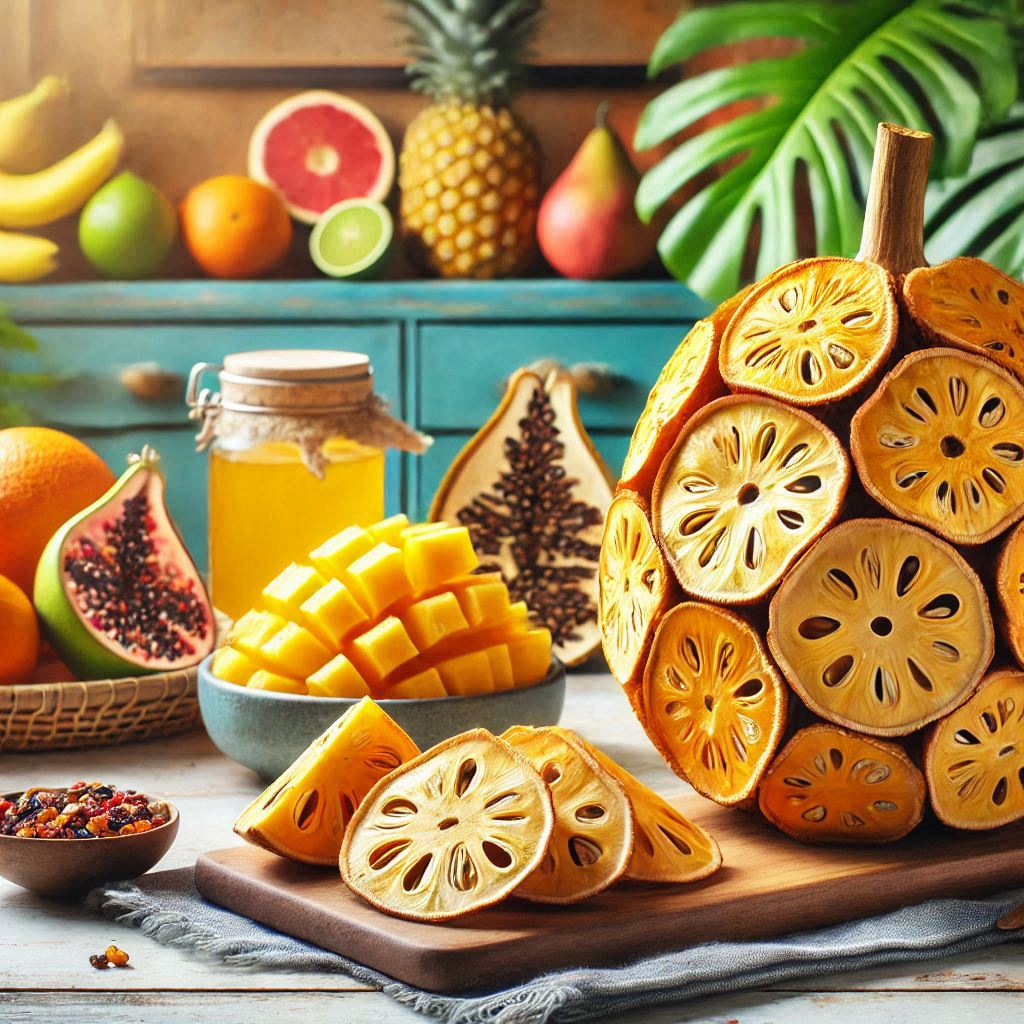
Introduction
Jackfruit is a remarkable fruit known for its versatility and unique characteristics. Not only is it celebrated for its sweet, tropical flavor when ripe, but it is also prized for its fibrous, meat-like texture in its unripe state, making it a popular meat substitute in various cuisines. This large, green fruit grows on the jackfruit tree (Artocarpus heterophyllus) and is packed with nutrients, offering a wide array of health benefits. As it continues to gain popularity around the world, jackfruit has established itself as a staple ingredient in both savory and sweet dishes, showcasing its adaptability and cultural significance.
Understanding the differences between dried and fresh jackfruit is crucial for both culinary enthusiasts and health-conscious consumers. Each form offers distinct flavors, textures, and nutrient profiles that can greatly impact your cooking and dietary choices. Fresh jackfruit provides a juicy and sweet experience, rich in hydration and essential vitamins, while dried jackfruit presents a chewy, concentrated flavor ideal for snacks or as an ingredient in various dishes. Knowing how these two forms vary can help you make informed decisions about which to use in your recipes, enhancing your meals while maximizing the fruit’s nutritional benefits.
The goal of this article is to educate readers on the fundamental differences and applications of both dried and fresh jackfruit.
What is Jackfruit?
The jackfruit plant, scientifically known as Artocarpus heterophyllus, is a tropical tree native to the Indian subcontinent and Southeast Asia. This impressive tree can reach heights of up to 80 feet, producing the largest tree-borne fruit in the world, which can weigh between 10 to 80 pounds. Jackfruit is characterized by its large, spiky, green exterior and sweet, aromatic flesh that encases numerous seeds. Historically, the jackfruit has played a vital role in the cultures and cuisines of the regions where it is grown, serving not just as a food source but also as a symbol of prosperity and sustenance. Over time, its popularity has spread globally, making it a sought-after ingredient in vegetarian and vegan dishes due to its unique texture and nutritional benefits.
Jackfruit is not only delicious but also packed with essential nutrients, making it a valuable addition to any diet. It is rich in vitamins, particularly vitamin C and several B vitamins, which support immune function and energy metabolism. Additionally, jackfruit contains dietary fiber, promoting healthy digestion and aiding in weight management. Its low calorie and fat content make it a great alternative for those looking to manage their weight without sacrificing flavor. Furthermore, jackfruit is a source of antioxidants, which help combat oxidative stress in the body. With its impressive nutritional profile, incorporating jackfruit into your meals can contribute positively to overall health.
Jackfruit’s versatility makes it a beloved ingredient in many culinary traditions around the world. In South Asian cuisines, particularly in countries like India and Bangladesh, young green jackfruit is often used as a meat substitute in savory dishes, cooked in curries or stir-fried with spices to create hearty meals. Its texture mimics that of pulled pork, making it a popular choice for vegan and vegetarian dishes. In Southeast Asia, ripe jackfruit is enjoyed fresh, often found in desserts, smoothies, or as a sweet snack. Its sweet, fragrant flesh can be blended into ice creams or used as a filling for pastries, delighting those with a sweet tooth. Additionally, in Caribbean cuisine, jackfruit is sometimes utilized in traditional recipes, such as jerk dishes or stews, further showcasing its adaptability. No matter the region, jackfruit continues to inspire creative recipes, allowing chefs and home cooks alike to explore its unique flavor and texture in various culinary contexts.
Fresh Jackfruit
Fresh jackfruit is notable for its unique taste, texture, and appearance. The outer skin is large and spiky, showcasing a vibrant green or yellow hue. Once sliced open, you’ll find its fibrous, yellow flesh containing numerous seeds. The taste is pleasantly sweet when ripe, with hints of tropical flavors, while unripe jackfruit has a mild, savory flavor reminiscent of pulled meat, making it versatile for both sweet and savory dishes.
When selecting fresh jackfruit, look for one that is slightly soft to the touch and emits a sweet aroma, indicating ripeness. Avoid those with dark spots or excessive blemishes. For storage, keep unripe jackfruit at room temperature until it ripens. Once ripe, it can be refrigerated for a few days. To maximize freshness, consume or prepare the fruit shortly after cutting, as it tends to oxidize and lose flavor.
Fresh jackfruit can be enjoyed in various culinary applications. Ripe flesh can be eaten fresh, added to smoothies, or blended into desserts like ice cream and cakes. Unripe jackfruit shines in savory dishes; it can be cooked in curries, stir-fried, or even grilled. One popular preparation method is to marinate and slow-cook it with spices, yielding a tender, meaty texture that makes for a delicious pulled jackfruit sandwich.
Incorporating fresh jackfruit into your diet offers numerous health benefits. It’s a great source of vitamins A and C, which support skin health and immune function. The fiber content aids digestion and promotes a feeling of fullness, making it beneficial for weight management. Additionally, jackfruit contains antioxidants that combat inflammation and may help reduce the risk of chronic diseases. The combination of low calories and high nutritional value makes fresh jackfruit a smart addition to a balanced diet.
Dried Jackfruit
Dried jackfruit is created through a meticulous dehydration process that removes moisture while preserving the fruit’s flavor and nutrients. This can be achieved through sun-drying, air drying, or using a food dehydrator. Each method allows for the retention of the natural sweetness of jackfruit, transforming its texture from fibrous to chewier. The process extends the shelf life significantly, making it a convenient option for snacking or incorporating into various dishes.
Dried jackfruit has a distinct appearance, characterized by its darker, more concentrated yellow-brown color. Its texture becomes chewy, while the flavor intensifies, offering a sweet taste that hits the palate with tropical notes, reminiscent of figs or apricots. Although it loses some of the juiciness of fresh jackfruit, the drying process enhances its sweetness, making it an appealing snack option.
When selecting dried jackfruit, look for pieces that are plump, not overly brittle, and exhibit a rich color without any signs of mold or excessive stickiness. High-quality dried jackfruit should have a pleasant aroma without any off-putting scents. For storage, keep it in an airtight container in a cool, dark place to maintain freshness, as exposure to air and light can cause deterioration in flavor and texture. Properly stored, dried jackfruit can last for months.
Dried jackfruit serves as a versatile ingredient in the kitchen. It can be enjoyed as a standalone snack, adding a sweet twist to trail mixes or granola. Additionally, rehydrated dried jackfruit can be incorporated into various recipes, such as curries and stir-fries, bringing a unique texture and flavor to traditional dishes. It can also be blended into smoothies or used in baked goods, like cookies and cakes, offering a healthy natural sweetener alternative.
While dried jackfruit retains many of the health benefits of its fresh counterpart, its nutritional profile differs slightly due to the drying process. Dried jackfruit is concentrated in sugars and calories, making it a quick energy source, but it also remains rich in fiber, vitamins, and antioxidants. The fiber content in dried jackfruit can aid digestion and promote satiety, beneficial for weight management. However, it’s essential to consume it in moderation due to the higher sugar content compared to fresh jackfruit, thereby balancing its inclusion in a healthy diet. In summary, dried jackfruit provides a nutritious and tasty snack with numerous culinary applications while delivering many of the health benefits of fresh jackfruit. Whether enjoyed as is or incorporated into recipes, it offers versatility and flavor that can complement a variety of dishes.
Nutritional Comparison
In this section, we provide a side-by-side analysis of the nutritional values of dried jackfruit versus fresh jackfruit, focusing on calories, vitamins, and minerals.
The drying process significantly alters the nutrient density and caloric content of jackfruit. Fresh jackfruit is largely composed of water, which means it has a lower caloric density, making it a great option for hydration and weight management. In contrast, dried jackfruit has a concentrated form of nutrients due to the removal of moisture, resulting in a higher calorie count and potential sugar concentration.
While both forms of jackfruit offer health benefits, they come with their own unique considerations. Fresh jackfruit is rich in hydration and lower in sugar, making it an excellent choice for those looking to maintain a balanced diet and manage caloric intake. Meanwhile, dried jackfruit provides a quick source of energy and is rich in fiber, vitamins, and antioxidants. However, due to its higher sugar content, it’s important to enjoy dried jackfruit in moderation to avoid excessive calorie intake, particularly for individuals watching their sugar levels. In conclusion, understanding the nutritional differences between dried and fresh jackfruit can help consumers make informed choices that align with their health goals.
Taste and Texture Differences
When it comes to flavor, fresh and dried jackfruit offer distinct experiences. Fresh jackfruit has a sweet, tropical taste with subtle notes of banana and pineapple, making it a delightful addition to smoothies, fruit salads, and desserts. Its juicy flesh enhances the overall freshness of dishes. In contrast, dried jackfruit has a more concentrated sweetness, reminiscent of candy, and a slightly chewy texture that makes it an appealing snack on its own. The drying process intensifies the flavors, resulting in a rich, caramel-like essence that can add depth to savory dishes such as stir-fries and salads.
The texture of jackfruit varies significantly between its fresh and dried forms. Fresh jackfruit is succulent and fibrous, offering a satisfying crunch when bitten into, which can elevate the overall sensory experience in salads or fresh salsas. Conversely, dried jackfruit’s chewy consistency provides a different mouthfeel, making it an excellent option for snacking or incorporating into trail mixes and granola bars. This transformation in texture can greatly influence the culinary applications of jackfruit, allowing for a range of creative uses in both sweet and savory recipes. In summary, the differences in taste and texture between fresh and dried jackfruit play a crucial role in how they can be best utilized in various dishes, offering unique experiences that cater to diverse palate preferences.
Uses in Cooking and Baking
Fresh jackfruit is a versatile ingredient that can be easily added to a variety of dishes. Its juicy, fibrous texture makes it an excellent choice for creating vibrant salads, tropical fruit bowls, and refreshing smoothies. Additionally, its natural sweetness pairs well with savory ingredients, allowing it to shine in dishes such as curries and stir-fries. One innovative way to use fresh jackfruit is to grill or roast it, enhancing its flavor and adding a delightful char.
Dried jackfruit opens up a world of culinary possibilities with its concentrated sweetness and chewy texture. It can be used in a range of both sweet and savory recipes. For instance, chopped dried jackfruit can be added to granola bars, oatmeal, and baked goods like muffins or bread for a natural sweetness boost. In savory dishes, it can be incorporated into soups, stews, or even used as a meat substitute in tacos or pulled jackfruit dishes, making it an excellent option for plant-based diets.
When substituting dried for fresh jackfruit, or vice versa, it’s important to keep in mind their differing moisture content and flavor intensity. Generally, a ratio of 1:3 can be used, meaning one part dried jackfruit can replace three parts of fresh jackfruit. If a recipe calls for fresh jackfruit, soaking the dried variety in warm water or juice can help rehydrate it before use, bringing it closer to the texture of fresh jackfruit. Conversely, when replacing dried jackfruit with fresh, you may need to adjust the sweetness level of the dish accordingly to ensure a balanced flavor.
Conclusion
In summary, whether you choose dried or fresh jackfruit, both forms offer unique flavors and textures that can elevate your culinary creations. Fresh jackfruit’s juicy, fibrous quality makes it a versatile addition to savory and sweet dishes alike, while dried jackfruit’s concentrated sweetness and chewy texture provide endless possibilities for snacking or cooking. We encourage you to experiment with both forms of this incredible fruit in your own kitchen. Don’t hesitate to share your experiences or favorite recipes using jackfruit with us and the community!






